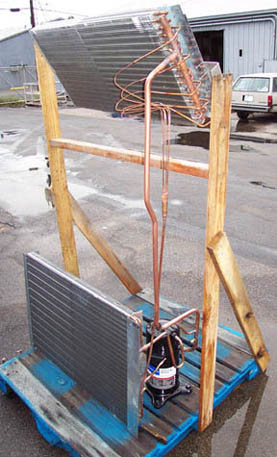
Typically, with this type of service, the coils are totally immersed in a dip coating process prior to the assembly of the unit. This particular coating system has a good reputation and is well known throughout the industry. However, after one year, the cooling circuit on this unit failed and is in need of replacement due to numerous leaks in the copper tubing.
The problem is, even though the entire condenser and evaporator may be covered with an effective coating system, the coils must ultimately be soldered into the copper cooling circuit. This results in sections of the tubing being exposed to the atmosphere.
In a marine or coastal environment, this may be an acceptable condition. Bare copper is fairly resistant to the corrosive effects of salty air. This is why, for many years, copper fin/copper tube (Cu/Cu) coils have been a popular (albeit expensive) solution for corrosion in marine applications. The all-copper coil will hold up reasonably well against salt air exposure, without the galvanic corrosion inherent with the dissimilar metals of uncoated aluminum fin/copper tube (Al/Cu) coils.
The catch is, what works well in one environment does not necessarily work well in another. Ask anyone who has ever installed a Cu/Cu coil in a sulfur or methane environment. Big mistake.
Cu/Cu coils are not a good solution for locations where the unit may be exposed to various aggressive acids and other chemicals. Several specific applications that come to mind are: waste water treatment, pulp and paper mills, refineries, chemical plants, meat and dairy processing, hog and mushroom farms, and others.

The solution for these types of environments is to provide an effective protective coating for all the exposed copper in the circuit as well as the copper on the condenser and evaporator coils.
Typically, an aftermarket modification/coating service provider can perform these services for new equipment. This is best done before the equipment goes into the field. Once corrosion starts, it is very difficult, and usually not cost effective, to contain. A small investment made wisely at the beginning of a project can bring big savings in terms of downtime costs, leak repairs, coil replacements, and unit efficiency losses (increased energy consumption).
Generally, this is how the exposed copper on a unit can be protected. On smaller units, the entire cooling circuit can be removed for coating. In addition to making the job easier, the circuit is not cut and the refrigerant does not have to be recovered. Larger units may require some disassembly for accessibility. The coils may need to be removed for coating depending on the extent of access and the coating system used. Either way, the galvanized end plates of the coils should be prepped in accordance with the coating system.
Both coils and all exposed tubing should be washed thoroughly with an effective detergent, rinsed, and allowed to dry. It is important to use a detergent that is effective, but not harsh, and one that does not leave a residue. A primer formulated for use on copper should be applied to all exposed tubing to provide an enhanced adhering surface for the topcoat. Once the primer is dry, the topcoat can be applied to both the tubing and coils. If the circuit has been cut when the coils are removed for coating, it must be re-soldered, tested, and the refrigerant re-installed. In this instance, the areas left uncoated for soldering will need to be washed, dried, and touched up with the primer and topcoat.

In Figure 2, the end plates of both the condenser and evaporator and all exposed copper (including the compressor) have been primed with a fast-drying, moisture-curing polyurethane penetrating primer developed specifically for HVACR equipment.
In Figure 3, an aluminum-impregnated polyurethane topcoat has been applied to the coils and over all the primed surfaces. This particular system utilizes a conversion agent on the aluminum coil surface, prior to the application of the topcoat, which enhances adhesion to the aluminum without adding layer thickness.
This particular 3-ton wall-mount unit is installed in a chemical plant in Texas.
Richard C. Griffin is with Blygold America Inc., whose products have been protecting HVACR coils and equipment installed in corrosive coastal, marine, and industrial environments for over 30 years. Blygold products are applied through a network of licensed applicators. For more information, contact 410-643-6080; info@blygoldamerica.com; or visit www.blygoldamerica.com.
Publication date: 09/22/2003

Report Abusive Comment